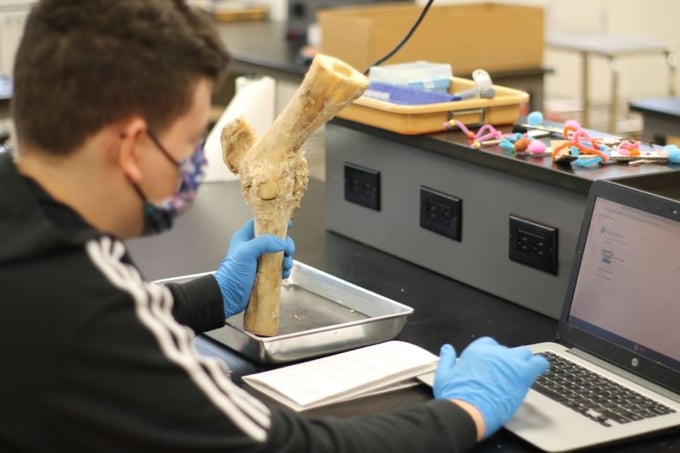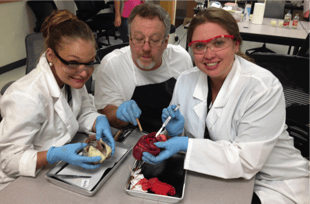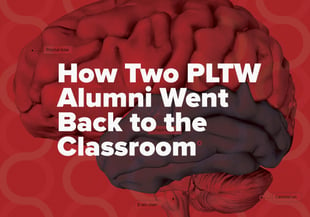Jean Lebegue and Samuel Thomas are teachers at Hoboken High School in Hoboken, New Jersey, currently teaching PLTW Biomedical Science courses.
Biomedical science is a subject that integrates the study of life (biology) with the study of medicine (the development and treatment of disease). From their freshman year on, students in the PLTW Biomedical Science track at Hoboken High School study biology in the context of health and medicine. Teaching biomedical science provides us, as educators, with the unique opportunity to go beyond simply teaching the theory and practice of biology and medicine but also allows us to integrate the principles of social and emotional learning (SEL) into the curriculum.
Social and emotional learning is defined as a “process through which children and adults acquire and effectively apply the knowledge, attitudes, and skills necessary to understand and manage emotions, set and achieve positive goals, feel and show empathy for others…” (source: casel.org) and more. We have found that the PLTW Biomedical Science curriculum is a great vehicle for teaching students SEL. Here are a few examples of SEL implementation using the PLTW curriculum.
Fostering a Mindset
We begin the freshman curriculum with a sequence of lessons focused on the work of Carol Dweck. We introduce the idea of the growth mindset to the students and show them a TED talk from Carol describing the theory of a fixed versus a growth mindset. People can have a fixed or growth mindset or a mindset that falls somewhere in between. Having a growth mindset, or belief that you can improve over time through hard work and dedication, is a prerequisite for success.
Within this initial sequence of lessons, we ask the students to do a “self-assessment” (a big part of SEL learning) in which they take a survey on their own beliefs about learning and self-improvement. Each question has a certain point value. Students total the points of all their responses in order to determine where they fall on the fixed-versus-growth mindset spectrum. The students are encouraged and challenged to foster a growth mindset as they progress through the PLTW Biomedical Science curriculum. New and challenging material is scaffolded and broken down in such a way that students find even the most difficult subject matter is indeed approachable. Knowledge and mastery are attainable through hard work and dedication. Best of all, our students are really able to observe their own personal growth between the beginning and end of the year through the use of periodical self-assessments.
Helping Students Become Sensitive to the Plight of Others
The study of medicine and disease is at the heart of human health, and in the PLTW Biomedical Science track, the study of human disease begins at the start of our students’ freshman year. Students are quickly acquainted with the difference between infectious and hereditary disease. They become aware of a wide variety of health conditions and disorders. In class, students discuss heart disease, diabetes, sickle cell anemia, infectious diseases including COVID-19, and many others. The students investigate crime scenes, are asked to refer to autopsy reports, discuss disease risk factors, and read journal entries of people suffering from diseases where they describe their symptoms. The discussion of medicine and biology is never done in a vacuum. We make an effort to show the “human” side of disease and human health – and Project Lead The Way sets us up well in this regard via the curriculum.
Many of the students have friends or close family members who suffer from the diseases we discuss. Students are always encouraged to share if they feel comfortable. Most students are eager to share their experiences with the rest of the class. Open class discussions are often held in which students discuss what it might be like for a person suffering from a particular disease. Through such discussions, the students are able to reflect on their own lives and how difficult everyday life must be for someone suffering from diabetes, heart disease, or cancer. Opening students’ eyes and minds to the perspective of other people and the difficulties they may be experiencing causes them to develop empathy, a key component of social and emotional learning.
One memorable example from the Principles of Biomedical Science course this year was when the students worked through “A Family Affair” lesson where they utilized molecular biology to determine which members of a family had Familial Hypercholesterolemia. Another example comes from “The Nosocomial Nightmare” lesson which raises student awareness of patients who get infected with diseases in the hospital setting when being treated for an unrelated cause. Finally, “The Emergency Response” lesson allows students to gain an appreciation of how medical professionals treat medical emergencies. With PLTW, students are not just learning about science and medicine – they are also becoming acutely aware of how fragile good health can be – which causes them to become appreciative of their own health and the health of those they care about. It once again increases their sensitivity (a vital tenet of SEL) to others who may be ill.
Creating a Classroom Culture in which Students Work as Teams
Throughout the PLTW Biomedical Science courses, students collaborate on a wide variety of projects and laboratory experiences. Students are always encouraged to help one another during experiential activities. One example from this year is when the students investigated the crime scenes in the Principles of Biomedical Science class. Each student collected one piece of evidence, measured its dimensions, weighed it, took photos of it, and put it into an evidence bag. The students compiled their photos and data on Google Classroom and shared it with the rest of the class. In this way, students collaborated on a group and whole class level to form conclusions.
Throughout the course, students pool data and collaborate on answers – within their own groups and between different groups. In this way, students get used to sharing – a key element of SEL. In addition, groups are constantly shuffled. Students learn to work with people from all walks of life and gain important social skills that will serve them well in life. By encouraging collaboration, a dynamic and positive classroom environment that more closely resembles “the real world” is created.
Open Discussions Create Mutual Respect
Students are always encouraged to share their ideas in class. Likewise, all opinions are welcomed and considered valid and valuable. Students are encouraged to speak their minds and ask questions in class. Doing so fosters SEL best practices as students learn to tolerate differences and learn that they can expand their thinking by listening to others and being open to their experiences.
Each day, we begin class with a “do now” activity. Students provide an answer to a question relating to the content currently studied and a discussion follows. One of the major tenets of SEL is to foster a classroom culture where students’ feelings and unique personalities are valued. Each student is expected to share a portion of the answer.
Students evaluate both themselves and each other – a vital SEL component. For example, in Unit 4 of Principles of Biomedical Science, students create healthcare innovations and present them to the rest of the class. Students are asked open ended questions such as “what do you think…” when evaluating each other’s work.
PLTW’s blog intends to serve as a forum for ideas and perspectives from across our network. The opinions expressed are those of each guest author.


